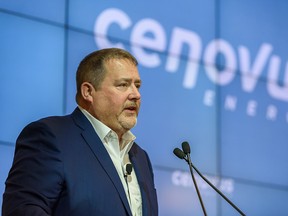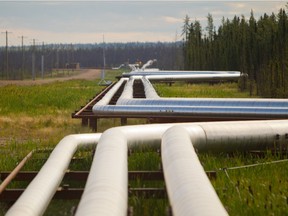Varcoe: Nuclear power could be 'holy grail' for oilsands, says Cenovus CEO
'If we're able to commercialize small modular reactors, you could see a scenario where you could completely decarbonize the upstream in Alberta'
'If we're able to commercialize small modular reactors, you could see a scenario where you could completely decarbonize the upstream in Alberta'
Author of the article:Chris Varcoe • Calgary Herald
Publishing date:Jun 08, 2022 •

Cenovus CEO Alex Pourbaix speaks at a news conference
on Thursday, January 30, 2020.
PHOTO BY AZIN GHAFFARI/POSTMEDIA
As oilsands operators build a blueprint to reach net-zero emissions by 2050, they’re not only turning to carbon capture, utilization and storage (CCUS) technology to reach their climate goals.
They’re also eyeing smaller nuclear power facilities in the oilsands.
As oilsands operators build a blueprint to reach net-zero emissions by 2050, they’re not only turning to carbon capture, utilization and storage (CCUS) technology to reach their climate goals.
They’re also eyeing smaller nuclear power facilities in the oilsands.
Speaking on the opening day of the Global Energy Show, Cenovus Energy CEO Alex Pourbaix said Tuesday the potential of small modular reactors is being examined by the Oilsands Pathways to Net Zero Alliance as one way to reduce emissions generated in bitumen production.
“Small modular reactors — I think that is, in many ways, almost one of the holy grails of decarbonizing the upstream oil and gas industry,” Pourbaix said at the event at the BMO Centre.
“We have the third-largest reserves of oil on the planet. They are incredibly concentrated. They very much lend themselves to a centralized facility to produce steam.
“If we’re able to commercialize small modular reactors, you could see a scenario where you could completely decarbonize the upstream in Alberta.”
The return of the annual Global Energy Show (formerly the Global Petroleum Show) after a two-year hiatus arrives as oil and gas prices have skyrocketed and the industry is posting hefty profits, but also facing daunting questions about future decarbonization plans.
The pathways alliance represents six of the largest oilsands producers in the country, including Cenovus, Suncor Energy and Canadian Natural Resources.
The group is striving to meet the federal government’s target of achieving net-zero emissions by 2050, which would allow the sector to produce among the most cost-competitive and carbon-competitive barrels in the world.
The alliance is initially working on a $14-billion project that would develop a carbon trunk line in the province, linking oilsands facilities to a CO2 sequestration hub located in the Cold Lake region.
However, it’s also looking at longer-term developments to reach its objective. A technology working group within pathways is studying the possibility of bringing small modular reactors (also known as SMRs) into the oilsands.
Thermal oilsands projects that use natural gas to create steam that’s needed to produce bitumen — generating emissions as well — could potentially turn to nuclear power instead.
The small-scale reactors can generate between two and 300 megawatts, compared to a larger — and more expensive — conventional nuclear reactor that can generate 1,000 megawatts.
“The challenge historically with large reactors, like a CANDU reactor, is they’re so big. They are just too big for any kind of regional purpose in the oilsands,” Pourbaix told reporters after the event.

Pipelines carrying steam, gas and an emulsion of bitumen and water snake through the boreal forest from well pads to the Cenovus Energy steam assisted gravity drainage oilsands facility near Conklin, Alta.
PHOTO BY RYAN JACKSON /Edmonton Journal
“The SMRs, if they’re able to become commercialized and licensed, they would actually be much smaller . . . (and) produce steam without any carbon emissions whatsoever.”
The Alberta government formally agreed last year to work together with Saskatchewan, New Brunswick and Ontario on the emerging technology.
Earlier this year, the four provinces unveiled plans that would see a 300-megawatt SMR facility built later this decade in Darlington, Ont.
“It has to happen. If they’re going to get to net-zero . . . and get other parts of industry to net-zero, we’re going to need everything,” Energy Minister Sonya Savage said on the sidelines of the three-day conference.
“We’re going to need CCUS. We’re going to need small modular reactors. We’re going to need increased renewables.”
Setting up a regulatory process and choosing an appropriate SMR design that’s suitable for the oilsands will take time.
The cost of building small nuclear plants in the oilsands is also uncertain, said Cenovus chief sustainability officer Rhona DelFrari.
She noted individual oilsands operators have previously looked at the potential of nuclear power to generate steam for their operations. The Canadian Oil Sands Innovation Alliance (COSIA) has also studied the technology.
More in-depth work will be required in the coming years, likely pushing any timetable for nuclear in the oilsands well into the 2030s.
“The expense is significant and it’s never been tried at the type of facilities that we have,” DelFrari said in an interview.
“Small modular reactors are still in their infancy . . . so that’s where government policy — and government participation as partners — can really help.”
Industry experts agree small-scale reactors hold potential for the oilsands.
The sector lowered its emissions per barrel by 20 per cent between 2009 and 2020, and SMRs could represent an even bigger change, said Richard Masson, former CEO of the Alberta Petroleum Marketing Commission.
“The companies need to make the evaluation . . . What level of risk are they willing to take on a technology that hasn’t been proven at a smaller scale yet?” said Masson, an executive fellow at the University of Calgary’s School of Public Policy.
Significant steps to get the Canadian oil and gas sector to net-zero will require new technologies. And billions of dollars of private-sector and public investment will also be needed to get there.
“It is becoming increasingly recognized this is the next investment boom for the oil and gas sector here in Alberta and really around the world,” analyst Randy Ollenberger of BMO Capital Markets told a panel on financing the energy transition.
“Just within Alberta between now and 2030, we’re probably (looking) at an investment range of $15 billion-plus. And by 2050, that number is probably going to approach $75 to $100 billion. So these are very significant investment opportunities.”
Chris Varcoe is a Calgary Herald columnist.
“The SMRs, if they’re able to become commercialized and licensed, they would actually be much smaller . . . (and) produce steam without any carbon emissions whatsoever.”
The Alberta government formally agreed last year to work together with Saskatchewan, New Brunswick and Ontario on the emerging technology.
Earlier this year, the four provinces unveiled plans that would see a 300-megawatt SMR facility built later this decade in Darlington, Ont.
“It has to happen. If they’re going to get to net-zero . . . and get other parts of industry to net-zero, we’re going to need everything,” Energy Minister Sonya Savage said on the sidelines of the three-day conference.
“We’re going to need CCUS. We’re going to need small modular reactors. We’re going to need increased renewables.”
Setting up a regulatory process and choosing an appropriate SMR design that’s suitable for the oilsands will take time.
The cost of building small nuclear plants in the oilsands is also uncertain, said Cenovus chief sustainability officer Rhona DelFrari.
She noted individual oilsands operators have previously looked at the potential of nuclear power to generate steam for their operations. The Canadian Oil Sands Innovation Alliance (COSIA) has also studied the technology.
More in-depth work will be required in the coming years, likely pushing any timetable for nuclear in the oilsands well into the 2030s.
“The expense is significant and it’s never been tried at the type of facilities that we have,” DelFrari said in an interview.
“Small modular reactors are still in their infancy . . . so that’s where government policy — and government participation as partners — can really help.”
Industry experts agree small-scale reactors hold potential for the oilsands.
The sector lowered its emissions per barrel by 20 per cent between 2009 and 2020, and SMRs could represent an even bigger change, said Richard Masson, former CEO of the Alberta Petroleum Marketing Commission.
“The companies need to make the evaluation . . . What level of risk are they willing to take on a technology that hasn’t been proven at a smaller scale yet?” said Masson, an executive fellow at the University of Calgary’s School of Public Policy.
Significant steps to get the Canadian oil and gas sector to net-zero will require new technologies. And billions of dollars of private-sector and public investment will also be needed to get there.
“It is becoming increasingly recognized this is the next investment boom for the oil and gas sector here in Alberta and really around the world,” analyst Randy Ollenberger of BMO Capital Markets told a panel on financing the energy transition.
“Just within Alberta between now and 2030, we’re probably (looking) at an investment range of $15 billion-plus. And by 2050, that number is probably going to approach $75 to $100 billion. So these are very significant investment opportunities.”
Chris Varcoe is a Calgary Herald columnist.
No comments:
Post a Comment